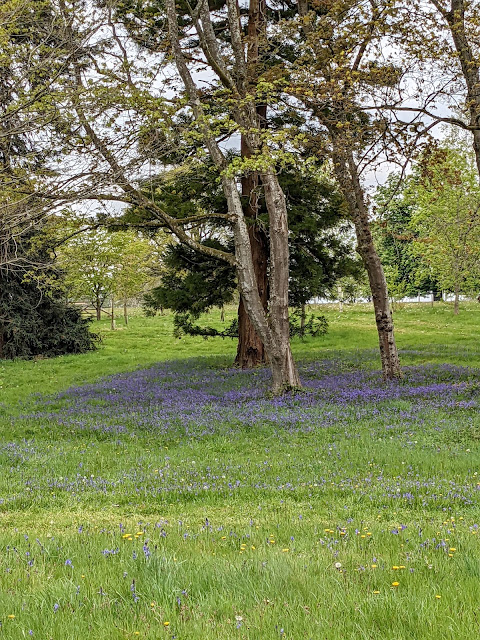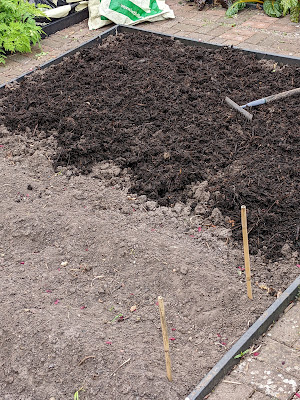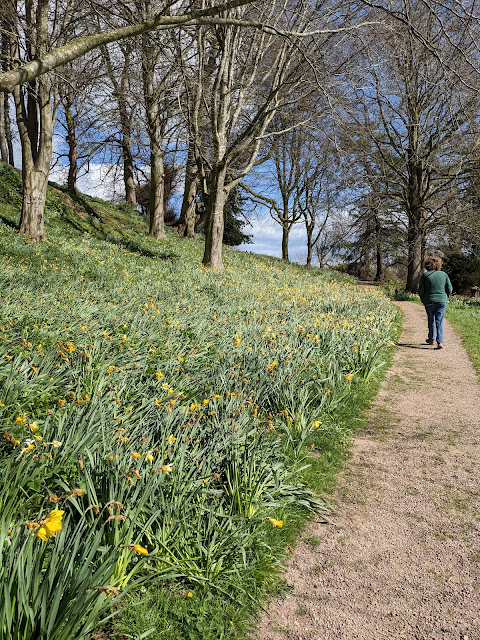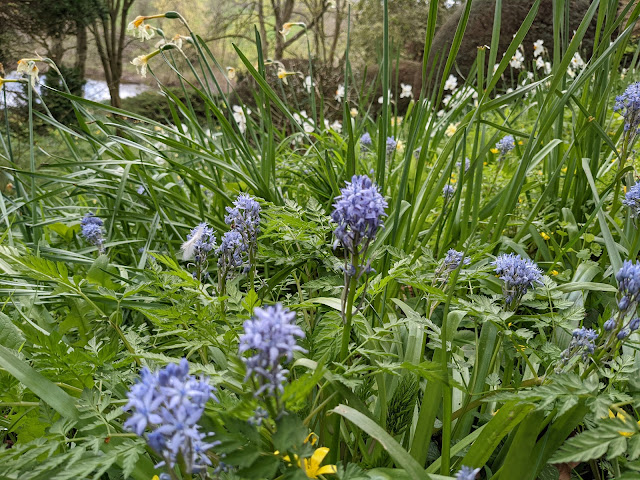I have always sown maincrop seed potatoes when the environmental conditions seemed right - generally, in mid-April when the ground has warmed, the probability of a late frost is low and the promise of April showers is in the air. Mary tells me they should be put in the ground on Good Friday to 'guarantee' a good crop. Since Good Friday can fall between March 20 and April 23, this makes absolutely no sense to me because there are so many other factors affecting crop yield (drought, flood, pests and diseases, nutrient availability, etc).
 |
| Chitted Sarpo Blue Danube Seed Potatoes |
The origin of the 'Good Friday' link with potato planting is hazy. There may be a religious connection - allegedly, Protestants would not eat potatoes because they are not mentioned in the Bible but Catholics were OK with them if planted on Good Friday (with or without a sprinkling of holy water) to drive off the devil. A more pragmatic explanation is that Good Friday is the first holiday after Christmas and, therefore, the first opportunity (for working people) to get some serious work done in the kitchen garden.
Yet another explanation relates this tradition to '
gardening by the moon'. I have seen this explained by the fact the moon is closer to the earth during full and new moons (higher gravitational effects) and this raises the water table in the soil and also influences water transport mechanisms in seeds and plants. Can the nearness of the moon have such an effect? Possibly, though I would expect the effect to be really
small. I remain sceptical the small changes in the
distance between the moon and earth around Eastertime have a big enough effect on the water table sufficient to affect crop health and yields. If there was an effect due the changes in the gravitational pull of the moon, then, at least for 2022, the
data suggests planting a week before Good Friday would be optimum. Happy to be convinced otherwise but it would need some supporting evidence!
Yet another idea is that rain follows both full and new moons and all gardeners and farmers appreciate some rain after sowing. The effect, if indeed it is an effect, seems
small and probably overwhelmed by other factors. No plausible mechanism has been suggested for the link between moon phases and precipitation.
So, back in the real world, on the 11th April, I decided it was time to plant the seed potatoes. I had considered putting the seed potatoes in the ground at the beginning of April as the weather had been reasonably warm. However, frost was forecast for the first weekend of April and then the second weekend; so I decided to wait until the outlook was frost-free. For those of a curious and scientific bent, the weather forecast was correctand there were frosts on both weekends.
I operate a 4-bed crop rotation system so I knew exactly where I was going to put the potatoes (blue area); the other half of the bed would be used for sweetcorn later in the year.
First of all, I needed to clear the
green manure planted at the start of October 2021. Normally, this would be dug into the ground and left for 2-4 weeks before planting as some green manures (e.g. rye grass) contain a chemical that inhibits seed germination though this is not an issue for seed potatoes. As my
hot composting bins were also in need of some soft green vegetation to give them a temperature boost, I decided to pull out the green manure,
shred it and add to my
Hotbin. Having cleared the plot...
...time to plant the seed potatoes. I am planting Sarpo Blue Danube again this year. We are still eating last year's crop so I know they keep well. Last season, I did not irrigate the crop: this year I will operate a moderate degree of watering and compare yields. There are
many ways to grow potatoes; traditionally, in the ground but also above ground under straw or black plastic and in containers. There are pros and cons to all of these methods so choose the one that suits you. I favour the traditional method of planting the potato about 15 centimetres below ground and then earthing up. Potatoes are a good crop for improving the tilth of the soil and preparing it for next season's crop - which should
not be more potatoes!
I received my seed potatoes on the 29th January and, about a week later, placed them on trays filled with shredded cardboard (an eggbox is an excellent alternative but we don't eat eggs). The trays were placed in a light airy room (16-18 ℃) to
chit. Commercial growers do not chit potatoes (too time-consuming) and chitting is mainly beneficial to give a kickstart to first and second earlies and early maincrop varieties. Blue Danube is an early maincrop so does benefit from chitting.
.jpg) |
| Chitted Blue Danube Seed Potato ready for planting out |
My 1.5 kg pack of Blue Danube seed potatoes contained 18 tubers and cost £6.45 from
D.T. Brown. I will, therefore, have three 2.4 metre (8 foot) rows with six seed potatoes in each row. The spacing within each row is about right for early maincrop potatoes though the rows are closer together than is generally recommended - an advantage of a raised bed system where cropping can be more intensive.
First, I mark out with canes the three rows and approximate positions for each seed potato. Then I create a trench about 5-6 inches deep using a rake - this avoids standing on the soil and compacting it - before using the short edge of the rake to loosen the soil in the bottom of the trench...
 |
| Preparing the first trench |
...seed potatoes are pushed into bottom of the trench, chitted end upwards...
 |
| Seed potatoes placed in the trench |
...and then covered with compost (unsieved)...
...before raking the soil back over the trench to form a ridge along the row...
Repeat twice more and then stand back and admire your handiwork!
 |
| Job done! |




























.jpg)












.jpg)



.jpg)










